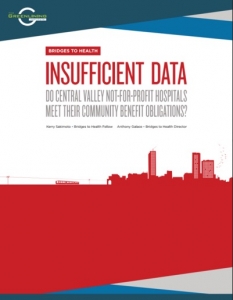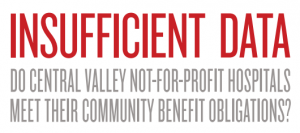
For the past several years, Greenlining has led a statewide coalition to advocate for not-for-profit hospitals to increase investments that improve the holistic health and well-being of communities of color and low-income communities. Each year, not-for-profit hospitals receive billions of dollars in tax exemptions and subsidies – totaling nearly $3.3 billion amongst not-for-profit hospital systems in California in 2010. In exchange, these hospitals are required to provide vital investments that address the health needs of the communities they serve, with an emphasis on building community health and disease prevention. These investments are known as community benefits.
Communities of color and low-income communities, California’s most vulnerable populations, have the most to gain from community benefits when these investments target the root causes of poor health – poverty, lack of access to healthy foods, and poor air and water quality, to name a fe w.
w.
I recently authored Greenlining’s newest report analyzing the community benefit practices of 11 not-for-profit hospitals in the Central Valley. The Central Valley is home to an overwhelming majority of communities of color – Latinos represent over 54 percent of the population, and people of color account for nearly two-thirds of Central Valley residents. While community benefit has the potential to make great strides towards health equity and improve health outcomes for the Central Valley’s most vulnerable communities, the information available regarding these investments is often vague and misleading. This makes it difficult to determine how hospitals actually invest their community benefit dollars, and whether they’re truly earning those tax breaks.
To make it simpler, here are four things you should know about not-for-profit hospital community benefits.
1. The goal of community benefit is to improve the health of communities but are they doing enough?

Community benefit has the potential to improve the health of communities of color and low-income communities in the Central Valley if invested towards upstream, preventive health solutions that target the root causes of poor health. By investing upstream, we create healthy environments that allow communities to stay healthy.
However, communities of color and low-income communities bear the brunt of chronic disease and poor health, especially in the Central Valley. Levels of asthma, diabetes, heart disease, hypertension, and other chronic illnesses rise as vulnerable communities continue to lack the resources and environmental conditions to stay healthy. Not to mention, the water crisis has left thousands of residents without access to clean water.
Poor health comes at a serious cost, both to community members and hospitals. Clinical treatment for diabetes, asthma, and other chronic diseases account for nearly $4 billion in costs every year. We will never find a solution if we only treat health problems in the emergency room. If Central Valley residents continue to live in communities without access to nutritious foods or environments with polluted air, then the health of vulnerable communities will only worsen.
2. Not-for-profit hospitals need to invest more in upstream, preventive health programs and services.
Unfortunately, not-for-profit hospitals only invest a small portion of their annual budgets towards upstream, preventive health solutions. On average, the 11 Central Valley hospitals from our recent study invested less than half a percent of their total operating expenses towards upstream, preventive health programs. Some hospitals in the study invested less than 0.001 percent. This amounted to only $6,319 out of a total operating budget of over $211 million.
Imagine if hospitals increased their investments to just one percent of their total operating expenses. This would result in significant strides towards improving health in the Central Valley without placing a financial burden on individual hospitals. Hospitals can and should do more to invest in upstream, preventive health solutions.
3. Not-for-profit hospitals fall short of meaningful community engagement in the community benefits process.

Not-for-profit hospitals are required to consult the communities they serve to determine how to invest their community benefit dollars and promote community health. However, not-for-profit hospitals in the Central Valley fall short of meaningful community engagement.
A joint community engagement strategy amongst nine of the 11 hospitals primarily relied on hospital employees during community focus groups and surveys. Another hospital only offered surveys in Spanish and English, excluding residents who spoke other languages.
In October, Greenlining hosted our own community benefit forum in Fresno to listen to what the most pressing health challenges facing communities were, and how community benefit could best improve health in the Central Valley. We learned three things: (1) community members are better suited at identifying health challenges that the hospitals are not aware of, including a lack of access to nutritious foods, safe places for families to play and exercise, housing, and the growing challenges of poverty and unemployment; (2) communities are incredibly interested in learning how community benefit can support health in the Central Valley; but (3) community members did not have access to information about community benefit resources.
Community members are the foremost experts on the health challenges facing their communities, and hospitals should develop comprehensive strategies to tap into that knowledge. They can start with simple actions, like offering child care and translation services, hosting community focus groups in accessible locations, and soliciting community input more
4. There is still a lot that we do not know about how community benefit dollars are being spent.

Unfortunately, our research revealed gaps in reporting throughout all 11 hospitals. In an effort to fill these gaps, I followed up with phone calls and emails to these hospitals weekly over three months. I received only one response.
Community members and advocates alike have a right to know how community benefit resources are being invested. When information is not transparent and accessible to the public, it makes it impossible to develop trust and partnership between hospitals and community groups. Hospitals must be accountable to their tax benefits and commit to transparent community benefit reporting.
We hope that this report will generate dialogue between communities and not-for-profit hospitals, and encourage greater investments towards upstream, preventive health. Greenlining is committed to building health in the Central Valley and across the state. Only together, can we move forward.
We hope our not-for-profit hospitals will join us in this effort.
Originally posted on the Greenlining blog.
